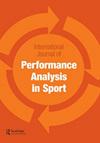An analysis of whole-body kinematics, muscle strength and activity during cross-step topspin among table tennis players
IF 1.6
4区 教育学
Q1 Health Professions
International Journal of Performance Analysis in Sport
Pub Date : 2022-01-02
DOI:10.1080/24748668.2022.2025712
引用次数: 2
Abstract
ABSTRACT This study examined the differences of muscle strength, electromyography (EMG) and whole-body kinematics during maximum cross-step table tennis topspin between advanced and intermediate players. Ten advanced and ten intermediate players performed both voluntary isokinetic contraction test and forehand topspin strokes with maximum-effort towards cross-court target zone. The results indicated that advanced players generated significantly greater maximum racket speeds during forward swing phase (P < 0.05). At the instant of the topspin stroke, significantly smaller shoulder horizontal flexion and elbow flexion angles, but larger joint angular velocities in advanced players (P < 0.05). Moreover, advanced players exhibited longer muscle firing duration of anterior deltoid and biceps brachii as well as higher root mean squares and EMG integrals of the abdominal external oblique, anterior deltoid and biceps brachii muscles than the intermediate players (P < 0.05). Furthermore, the isokinetic results showed higher shoulder abduction/adduction, hip flexion/extension and knee flexion torques at fast speed (240°/s) and higher elbow flexion torque at medium speed (120°/s) in advanced players (P < 0.05). The findings suggest that higher activation of the deltoid, biceps and abdominal external oblique muscles as well as larger muscle strength under higher speed conditions would be the plausible key factors to maximise racket and joint angular velocities in forehand topspin.乒乓球运动员跨步上旋时的全身运动学、肌力和活动性分析
摘要本研究考察了高级和中级运动员在乒乓球最大跨步上旋过程中的肌肉力量、肌电图和全身运动学的差异。10名高级和10名中级选手进行了自愿等速收缩测试和正手上旋击球,最大限度地朝着跨场目标区努力。结果表明,在前挥杆阶段,高级球员产生的最大球拍速度明显更高(P<0.05)。在上旋击球瞬间,高级球员的肩部水平屈曲和肘部屈曲角度明显更小,但关节角速度更大(P<0.05),高级运动员的三角肌前肌和肱二头肌的肌肉放电持续时间更长,腹部外斜肌、三角肌后肌和肱三头肌的均方根和肌电图积分也高于中级运动员(P<0.05),髋关节屈曲/伸展和膝关节快速屈曲力矩(240°/s)和肘关节中速屈曲力矩(120°/s)(P<0.05),二头肌和腹部外斜肌以及在更高速度条件下更大的肌肉力量将是在正手上旋中最大化球拍和关节角速度的可能关键因素。
本文章由计算机程序翻译,如有差异,请以英文原文为准。
求助全文
约1分钟内获得全文
求助全文
来源期刊

International Journal of Performance Analysis in Sport
SPORT SCIENCES-
CiteScore
4.70
自引率
4.80%
发文量
38
审稿时长
>12 weeks
期刊介绍:
The International Journal of Performance Analysis in Sport aims to present current original research into sports performance. In so doing, the journal contributes to our general knowledge of sports performance making findings available to a wide audience of academics and practitioners.
 求助内容:
求助内容: 应助结果提醒方式:
应助结果提醒方式:


